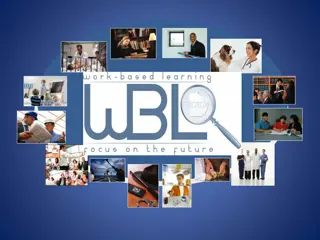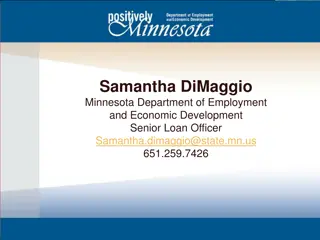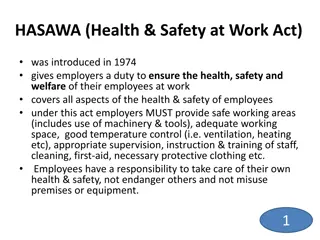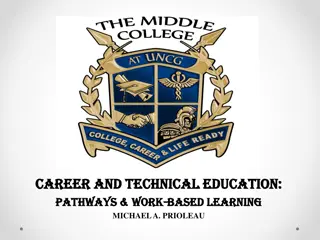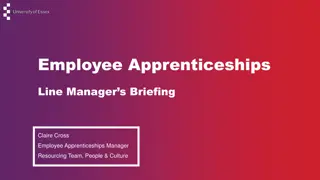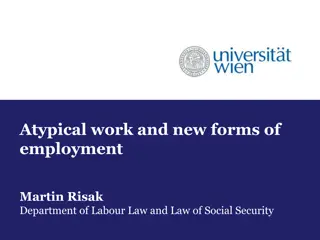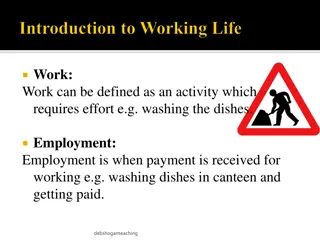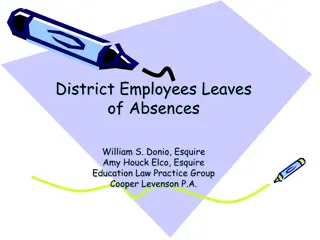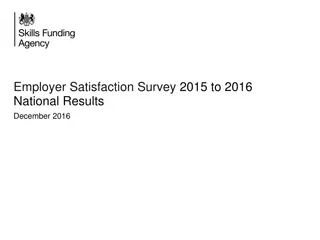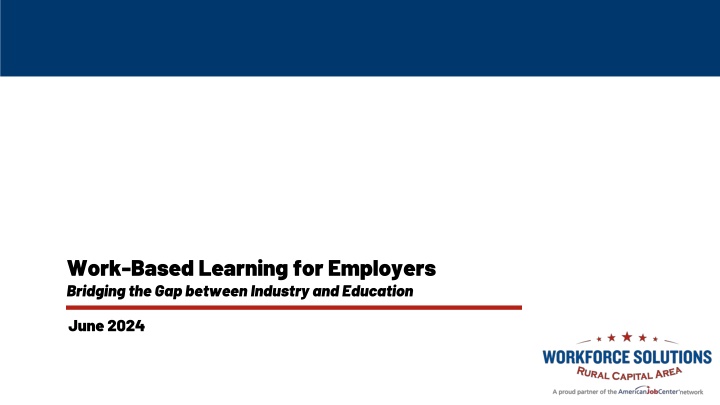
Bridging the Gap: Work-Based Learning Strategies for Employers
Explore the concept of work-based learning and its benefits for employers, focusing on bridging the gap between industry and education. Discover how structured hands-on experiences can develop industry-specific skills, enhance talent pipeline development, and foster innovation and diversity in the workforce. Find out various ways to get involved, from guest speaking to apprenticeships, to create a skilled and motivated workforce tailored to your organization's needs.
Download Presentation

Please find below an Image/Link to download the presentation.
The content on the website is provided AS IS for your information and personal use only. It may not be sold, licensed, or shared on other websites without obtaining consent from the author. If you encounter any issues during the download, it is possible that the publisher has removed the file from their server.
You are allowed to download the files provided on this website for personal or commercial use, subject to the condition that they are used lawfully. All files are the property of their respective owners.
The content on the website is provided AS IS for your information and personal use only. It may not be sold, licensed, or shared on other websites without obtaining consent from the author.
E N D
Presentation Transcript
Work-Based Learning for Employers Bridging the Gap between Industry and Education June 2024
The Future of Workforce Development Bridging the gap between education and industry Bridging the gap between education and industry Foster a skilled and motivated workforce tailored to Foster a skilled and motivated workforce tailored to your specific needs your specific needs
What is Work-Based Learning? Partnering with educational institutions or training Partnering with educational institutions or training providers providers Structured hands Structured hands- -on experience on experience Real Real- -world environment world environment Allows participants to develop industry Allows participants to develop industry- -specific skills, knowledge, and competencies skills, knowledge, and competencies Contributes to the goals and operations of employer Contributes to the goals and operations of employer organization organization specific
Benefits Talent Pipeline Development Talent Pipeline Development Customized Training Customized Training Increased Retention Increased Retention Innovation and Diversity Innovation and Diversity
Ways to get Involved Guest Speaking Guest Speaking Career Day Participant Career Day Participant Facility Tours Facility Tours Donate Equipment/Set up Student Donate Equipment/Set up Student Learning Space Learning Space Job Shadowing Job Shadowing Serve on an Advisory Board Serve on an Advisory Board Mentorships Mentorships Internships Internships Mock Interviews Mock Interviews Apprenticeships Apprenticeships
Guest Speaking Address an audience Address an audience Provide insights, knowledge, or inspiration about Provide insights, knowledge, or inspiration about your work your work Typical Time Commitment: Typical Time Commitment: 3 3 6 hours (including travel, preparation, presentation, Q & A, 6 hours (including travel, preparation, presentation, Q & A, and follow and follow- -up) up)
Facility Tours/Field Trips Offer students the opportunity to tour your facility Offer students the opportunity to tour your facility Provide first Provide first- -hand experience of operational hand experience of operational processes processes Typical Time Commitment: Typical Time Commitment: 3.5 to 6.5 hours (including preparation, the tour itself, Q & A, 3.5 to 6.5 hours (including preparation, the tour itself, Q & A, and follow and follow- -up) up)
Job Shadowing Enables a student to spend time with a specific Enables a student to spend time with a specific industry professional industry professional Typical Time Commitment: Typical Time Commitment: 5.5 to 13 hours (including preparation, shadowing period, and 5.5 to 13 hours (including preparation, shadowing period, and post post- -shadowing activities such as debriefing and providing shadowing activities such as debriefing and providing feedback) feedback)
Mentorships Structured, school coordinated methods that enable Structured, school coordinated methods that enable a student to learn about an industry and the a student to learn about an industry and the workplace from a selected professional who has workplace from a selected professional who has experience in the field experience in the field Typical Time Commitment: Typical Time Commitment: 20 20- -64 hours over a 6 64 hours over a 6- -month period, depending on the month period, depending on the frequence of meetings and involvement in additional activities. frequence of meetings and involvement in additional activities.
Mock Interviews Allow students to practice their interview skills with Allow students to practice their interview skills with a professional a professional Typical Time Commitment: Typical Time Commitment: 4 4- -7 hours, including preparation, length of interviews and the 7 hours, including preparation, length of interviews and the level of feedback provided. level of feedback provided.
Career Day Participant Showcase your work for students in an expo Showcase your work for students in an expo- -like setting setting like Typical Time Commitment: Typical Time Commitment: A full work day, including coordination, setup, the event, and A full work day, including coordination, setup, the event, and take down take down
Donate Equipment/Setup Student Learning Space Donate equipment to simulate the work Donate equipment to simulate the work- -place place Visit the classroom to set up real Visit the classroom to set up real- -world simulation for student learning for student learning world simulation Typical Time Commitment: Typical Time Commitment: None for donations None for donations Varies for classroom setup Varies for classroom setup
Serve on an Advisory Board Offer tailored guidance on program curriculum Offer tailored guidance on program curriculum Maintain first Maintain first- -hand awareness of classroom hand awareness of classroom activities activities Typical Time Commitment: Typical Time Commitment: Quarterly Meetings Quarterly Meetings two hours each two hours each
Internships Enable students to gain applied experience Enable students to gain applied experience Enable students to build professional and technical Enable students to build professional and technical skills skills Enable students to make connections in a field of Enable students to make connections in a field of interest interest Typical Time Commitment: Typical Time Commitment: 6 6- -13 hours per week per intern, ranging from 59 13 hours per week per intern, ranging from 59- -131 hours for a typical 10 typical 10- -week internship, including recruitment, onboarding, week internship, including recruitment, onboarding, training, supervision, project oversight, and post training, supervision, project oversight, and post- -internship activities activities 131 hours for a internship
Apprenticeships Hands Hands- -on learning programs where individuals gain on learning programs where individuals gain skills through practical experience alongside formal skills through practical experience alongside formal education, often leading to certification in a specific education, often leading to certification in a specific trade or profession trade or profession Typical Time Commitment: Typical Time Commitment: 9 9- -22 hours per week for apprentice, with a total ranging from 22 hours per week for apprentice, with a total ranging from 228 228- -528 hours for a typical 6 528 hours for a typical 6- -month apprenticeship. Time month apprenticeship. Time includes program development, recruitment, onboarding, includes program development, recruitment, onboarding, ongoing training and supervision, project oversight, and regular ongoing training and supervision, project oversight, and regular evaluations. evaluations.
Interested in Getting Involved? Scan the Code Scan the Code



